1978 Chevrolet Monte Carlo Landau: Downsized decadence

The first-generation Monte Carlo was Chevrolet Division’s answer to the 1969 Pontiac Grand Prix, which moved from a full-sized personal-lux coupe to a midsize in 1969, albeit with accompanying pool table-sized hood. It was immediately successful and, although based on the Chevelle coupe, was differentiated with its own alligator hood and riding upon the 116-inch Chevelle sedan wheelbase.
Yes, personal luxury was on the way, even as the final fire-breathing muscle cars appeared in showrooms across the land. But in a few short years, the midsize luxury coupes from GM were going to take over. By 1978 safety and fuel economy standards—along with changing tastes—resulted in an all-new Monte Carlo.

It was a smaller Monte Carlo, following in the footsteps of the full-size GM cars that had shrunk in 1977. As had been oft-told, GM realized sometime in the early ’70s that its full-sized cars were getting too big, and the decision was made to make the next round of new cars smaller. Thanks to CAFE, two fuel crises, and the lead time involved in rolling out an all-new automobile, the ’77 Caprice Classics and Impalas hit just as people were getting tired of parking and fueling their Nimitz-class cruisers. And in ’78, it was the midsize cars’ turn.

All the A-body cars, from LeMans to Century to Malibu, shrunk appropriately. In 1977, the Colonnade midsizers were actually about the same size as the brand-new full size cars, though the big cars had more interior room and trunk space. But order was restored for 1978. And as the A-Special cars— Monte Carlo, Grand Prix, Cutlass Supreme, and Regal—were cash cows, many of the Colonnade styling cues were retained on the new, smaller coupes.

There was no questioning it was smaller. Gone were the long, long hood and front fenders, though the neoclassical fender blisters remained as a nod to the ’73–77 Monte Carlo. The stacked quad headlamps were gone, replaced with dual rectangular units. The formal grille remained, but with a tight grid pattern. And the taillights went from vertical to horizontal.

Interiors were still plush, especially in red velour! Bucket seats and a console were also available, along with the expected power windows, power door locks, power trunk, and power Skyroof. Production was good, with 216,730 Sport Coupes and 141,461 upper-crust Landaus built for the model year, though that was down from the 411,000 Monte Carlos built the year before.
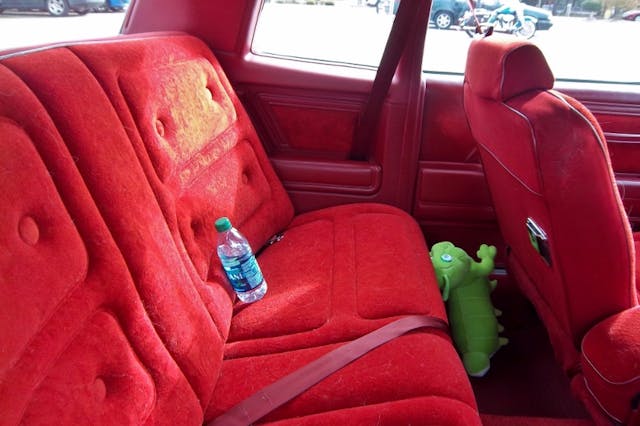
The first noticeable thing about the 1978 Monte Carlos were their reduced size, naturally. They were a foot shorter, 800 pounds lighter, and sported a V-6 for the first time ever; all 1970–77 Monte Carlos came out of the factory with a V-8. Standard engine was a 231-cubic-inch V-6, with a 305-cu-in V-8 optional.
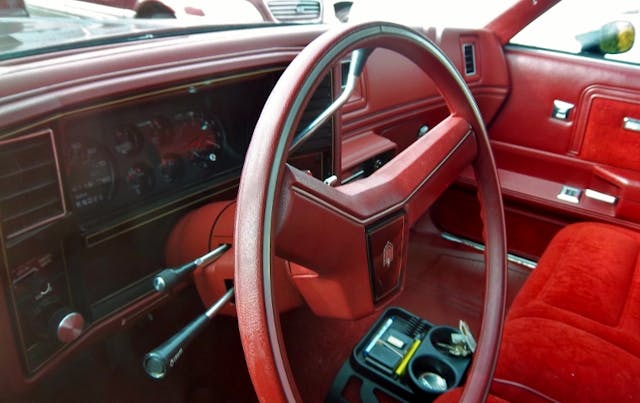
The Landau, top-of-the-line Monte Carlo since 1973, added an Elk-grain landau vinyl roof, pinstriping, power steering, power brakes, deluxe wheel covers, broader chrome sill moldings, and color-keyed sport mirrors, among other extras.

A T-top was optional if you wanted even more sky than the power sunroof offered. And, of course, there were the expected stereo options, including a cassette tape player, 8-track player, or AM/FM unit with an integrated citizens’ band radio.

The cheapest ’78 Monte was the V-6 Sport Coupe at $4785 ($22,079 today); top dog was the V-8 Landau, for $5828 ($26,891). Of course, with all the optional extras, that could be pushed much higher when A/C, cruise control, sun roof, and other items were added to the total.
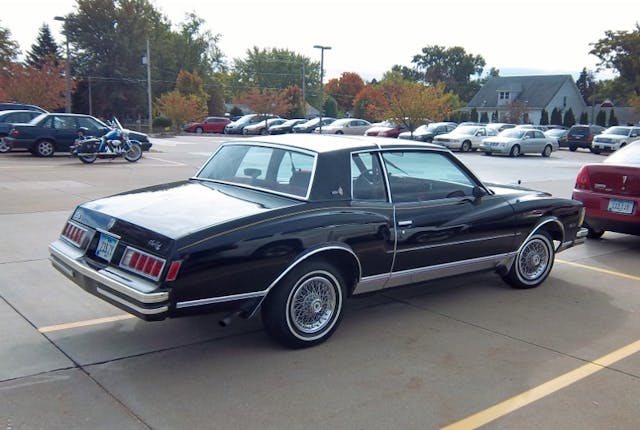
And the two-model Monte Carlo line, with 358,191 total ’78 sales, very nearly outsold the also all-new Malibu line, which included coupes, sedans, and station wagons. How close was it? Very—358,636 base Malibus, Malibu Classics, and Malibu Classic Landaus were built. Yes, coupes were still king in 1978. Especially personal luxury coupes. This basic body style carried on through 1980 with only minor facelifts, though the ’80 got a new quad-headlamp fascia. In 1981, all the GM midsize personal-lux coupes would get new sheet metal, though they still rode the 1978 chassis.

I spotted this showroom-condition example locally in October 2012 while running errands. I was agog at how nice it was and immediately had to park and check it out. It’s always nice to see a clean, original car like this with such a caring owner. It really shows.
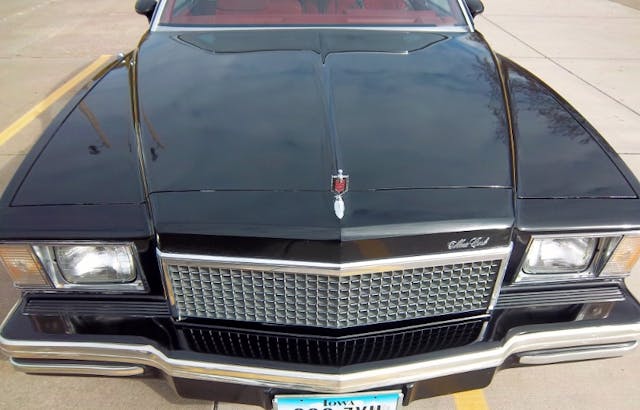
As for the Monte Carlo itself, the ’81 style lasted to 1988, then disappeared from the Chevrolet line. It returned in 1995 as a two-door version of the redesigned Lumina sedan. In 2000, it was redesigned along with the Lumina sedan (newly renamed Impala) and lasted to 2006. The storied name is unlikely to make a reappearance in today’s truck-, SUV-, and crossover-obsessed car market, but the vintage ones will always be around, whether at a car cruise, car show, or just being driven and spotted my an admirer on a nice autumn day.

Oh, and for folks who share my love of cars like these, Johnny Lightning recently (October 2022) released a ’78 Landau in 1/64 scale … in the exact same color combo! Of course, I bought one.
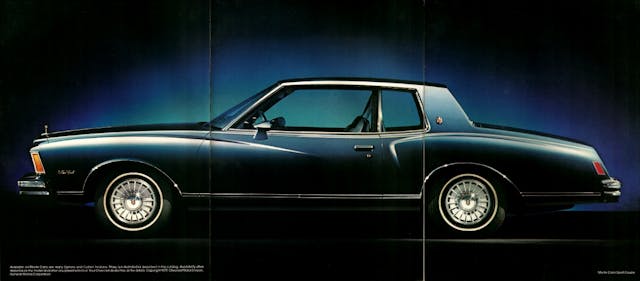
***
Check out the Hagerty Media homepage so you don’t miss a single story, or better yet, bookmark it. To get our best stories delivered right to your inbox, subscribe to our newsletters.


My Poppa had a 74. As a kid I didn’t think much of these later ones compared to the presence his was.
Today, I wish I could buy either at a GM dealership.
A car, distinct lines, suited to the purpose (personal luxury niche), real back seat roofline. Add in awd and a red interior…
Looking for 88 Cutlass Classic or around that date. For a reasonable price
My father bought my mother the exact same car with the exception of a red pinstripe in the fall of 1977, I remember driving it home with my father to surprise my mom and upon pulling it into our street it promptly overheated and steam billowed from under the hood! It turned out the fan belt had somehow slipped off…
McDermott Chevrolet sent out a service man who popped it back on and we drove it for the next 2 years with no problems.
My 2nd car in 80 was a 74 Monte, my Dad bought an 80 Anniversary Special ( Gold and Black 2 tone) in about 85. Drove the wheels off it for 12 or 15 years, then gave it to my son, who drove the wheels off it. 267 sbc sound right. Weird little oddball V-8
Probably my least favorite Monte Carlo, not that I am a big Monte Carlo guy. I still love the looks of the later Monte Carlo SS. The front wheel drive ones were just Chevy Lumina’s.
By the same logic, the original Monte Carlos were just Chevelles, then. Personally, I am partial to the 2005-2007 Montes with the LS4 V-8. Plenty of power, decent MPG, and quite capable in the winter.
70-72 we’re not just Chevelles.
Kin the Grand Prixs, yes.
The wheel base was different, engine position. Was different, suspension bushings were different. Disc brakes were standard, and so forth.
The Monte Carlo actually was made thru the 2007 model year.
My 1972 Grand Prix in white with red landau and interior was my Detroit favorite, even when the sunroof stuck open driving north to snowy Pennsylvania one winter’s day. This 400 CI beast was followed for 20 years by too many mediocre vehicles including a well appointed 1978 Regal with its anemic V6
My ’78 was the best $150 I ever spent. Blast to drive and you didn’t have to worry about dings and dents. Had an aluminum trunk which I thought was odd.
I own another strange G-body from 1978. It is a Cutlass Salon Brougham 2 door coupe almost identical to it’s bretheren, Cutlass Supreme. Most came with a anemic 231 V6. Mine has a small 260 V8, 2bbl. Not much power but smooth. I once owned when new, a 1978 Buick Century Custom. A cousin to the Olds Cutlass Salon. In fact, they were both sold by nearby dealers at the same time. The Buick was a very pretty red/red interior but the paint cracked terribly. the power was nominal in the mountains. Other than that it was a nice quiet car, better built than the Chevy Malibu’s of the era. The Olds is a light green with green interior. They were looked at when new as an odd duck. But, today I drive it to a car show like Hot August Nights, I get offers to sell it! Times and tastes changed. I recently bought a 1978 Olds 88 Holiday coupe with 48,000 original miles. A very pretty original sky blue paint with a half padded vinyl roof and a blue interior with bucket seats and a console. It is powered by the 350 Olds engine. I finally got it to pass CA smog and it runs nice with cat-back duals. I have had several offers to sell the car. So, the 70’s and 80’s cars are attracting attention that maybe the monicker of maliase has worn off some. My 84 Olds Custom Cruiser wagon gets the most attention as baby boomers like me remember riding in a wagon with mom and dad thinking, these cars are rank! Especially when you were seen by your school buddies!
Nice really nice
The 1978 model year debut of the 108.1 wheelbased & full perimeter frame of the General Motors’ A/G body chassis siblings marked the finest ever GM frame & chassis design ever. Now certainly the factory GM engines and transmissions that were factory equipment in those 1978-1987 GM cars were mostly poorly built P.O.S. compared to anything from that same era from the Japanese automakers.
This is not to say that one cannot overcome the horrible piece of trash original equipment mechanicals of those GM cars of that era. The engine and transmission designs were certainly not bad, its just that they have significant flaws due to the quality of certain original equipment components.
GM does have a distinguished history of having once built the world’s best and most durable AUTOMATIC TRANSMISSION, namely the Turbohydramatic 400 (TH-400) that arrived in 1965 for Cadillac…….then arrived for 1966 model Buicks, Oldmobiles & Pontiacs……..then for the 1967 model year there was an introduction of a Turbohydramatic 400 (TH-400) for the Chevrolet engine. As you all know the Buick Olds Pontiac Caddy bellhousing bolt pattern DIFFERS from Chevrolet. The Chevy TH-400 version was offered in the full sized Chevrolet Impala/Caprice from 1967 through about 1969.
General Motors issued a lighter weight and slightly smaller three speed automatic (TH-350) for Chevrolet products, and this essentially replaced the better/stronger TH-400 in Chevrolet passenger cars for 1970 model year. The TH-350 is a really good Automatic Transmission, however the bigger/stronger/better TH-400 is the world’s best in terms of long term durability and reliablity.
The TH-350 is no slouch either, as it is really good, reliable and durable!
What happened towards the mid to late Seventies is that GM engineering was scrambling to attempt to get better fuel economy from its products in the least expensive manner. Looking back, they cut too many corners in the utilization of what turned out to be crap materials that would prematurely fail. They didn’t have the prior expertise trying to maximize fuel economy and attaining federal emissions standards. They also were trying to do this as fast as possible, by the seat of their pants because prior to the Oct 1973 start of the oil crisis (Arab Oil Embargo), none of the Detroit automakers gave a rats phart about the MPG of any of their cars excepting perhaps your bare bones low buck Falcons,Corvair,Valiant,Rambler American, Chevy II,the GM captive imported from its German subsidiary OPEL Kadette line, the Ford captive imported Ford Cortina, and later the Ford Maverick, the AMC Hornet/Gremlin, the Chevy Vega, & the Ford Pinto.
Other than those few cars that originally were designed to become America’s Answer to competing with the Volkswagen. Other than for those few cars, product designers at the big three did not care at all about fuel economy (MPG miles per gallon). Regular gasoline was $0.32 per gallon in September 1973 before it began to skyrocket. What was significantly worse than that was that you then saw gasoline rationing in late 1973 where you could not buy enough gasoline to drive your Cadillac/ LINCOLN/Chrysler/Dodge/Buick/Oldsmobile/Pontiac/Big chevy/Big FORD/Plymouth/AMC Ambassador/AMC Matador on a daily basis because they only got typically between 7MPG (caddillacs/pontiacs/huge chryslers/lincolns) to 11MPG or 12MPG for Ford/Chevrolet/some Oldsmobiles…….
When faced with rationing of only being able to FILL UP on even or odd days depending upon your license plate number (limited to maximum of 15 gallons every other day)…….think about it 15 gallons X ten Miles Per gallon gives you a 150 mile range over a two day period. It becomes exponentially worse if you then are limited to a maximimum of 10 gallons of gas every other day, or if you are stuck waiting for two hours in a cue at the gas station that hasn’t yet run out of available fuel. Suddenly those Datsuns , and Toyotas that got 28 MPG became all the rage, even for very wealthy land yacht owners.
As the 5th Dimension and the Mamas & Papas once sang: “You Gotta Go Where You Wanna Go….”
Americans found that they didn’t enjoy the lack of freedom during that tense short time where they couldn’t get enough gas for their 10 mpg land yachts to commute back and forth to work.
Now suddenly they never again wanted to be forced to carpool because they couldn’t get enough gas for the land yacht………..they began to consider the MPG of whatever prospective Detroit product or land yacht in order to be able to go where and when they wanted to go. Money wasn’t an issue with the wealthy as they could easily deal with doubling or trippling or even perhaps quadrupling of the price of a gallon of gasoline. It never got that bad of course, but they certainly cannot stand the inability to obtain an ample supply of gas to allow them to go where they wanna go when they want to go there.
GM’s engines and transmissions of the mid seventies and beyond were mostly poorly refined and weren’t sufficiently long term torture tested prior to being issued as original factory equipment in new vehicles.
GM engineering was so far behind the 8 ball as far as the MPG and Emissions goals, that it made compromises that in perhaps otherwise more normal times, that it would not have.
In fairness to GM, FORD was no better, and Chrysler was the worst in efforts to achieve MPG & Emissions goals. Although GM engineering sucked in correcting quality control problems with their engines and transmissions of the late seventies through the mid eighties, their engineering with respect to the chassis, steering, brakes, suspension of both the NEW for ’78 full perimeter frame 108.1 inch wheelbase, with four link coil sprung rear axle was superb, just as it had been for the NEW for ’77 full perimeter 116 inch wheelbase downsized full size Chevy Caprice…etc. The NEW for ’78 monte/cutlass/regal/grand prix etc has GENERAL MOTORS’ finest full frame design ever. These ’78-’87 a/g body 108.1″ wb chassis are superb from a Predictable Handling/Excellent Braking/Superb Steering/Great Comfortable Ride standpoint. NEW REPLACEMENT PARTS TO THIS DAY ARE SUPER INEXPENSIVE AND AVAILABLE AT AUTO PARTS STORES EVERYWHERE for these GREAT ’78-’87 a/g GM 108.1 wb full framed chassis.
You can easily INSTALL nearly any GM v8, GM v6, GM inline 6 THAT YOU’D EVER CONSIDER DECENT ENOUGH TO INSTALL into that full framed chassis. It is already set up to easy accept of course the Chevy small block V8, the Buick V6, the Chevy V6, the Oldsmobile 350 v8, the CHEVROLET 250 inline six (ALTHOUGH ONLY MEXICAN MARKET ’78-’87 a/g bodies SAW THE INSTALLATION of the 250 INLINE SIX)……………. Sure, it only saw the OLDS 260 v8 in the ’78 cutlass but the superior OLDS 350 v8 is physically-exterior dimensionally the same………………Even the very ancient 1964 through 1967 BUICK 300 v8 (seen in ’64-’67 skylarks & specials) will be great in any as long as you choose to use a GM TH-400 for BOP, or use a late eighties-nineties Borg-Warner T-5 five speed if you wanna build a 5 speed manual
car . That ancient BUICK 300 v8 is lighter than the small block Chevrolet v8 by about close to 100 pounds………very close to the weight of a Ford 5.0 /302/289 v8. That BUICK 300 v8 is a CAST IRON block V8 that replaced the ’61-’63 215 aluminum v8. 1964 model 300v8 came with aluminum heads on the cast iron block…..1965, 1966, & 1967 ARE cast iron heads on cast iron blocks…….THESE 1965-1967 Buick 300 V8 are about 100 pounds lighter than a small block Chevy V8. Buick completely redesigned their engine family for the 1968 model year, so the 300 V8 of (1964, 1965, 1966, 1967 ) is unique and it is the lightest cast iron V8 engine that GM produced prior to the introduction of the LS1 revised version of the Chevy small block. The current day MGB engine swappers have re-discovered the mid Sixties BUICK 300 v8 since the supply of complete used 1993-1995 Chevy 3.4 V6 engines from (’93-’95 firebird-camaro) has dried up. I am not saying that the BUICK 300 is your best choice. I am only pointing out that even something so ancient will easily go into the ’78-’87 a/g body. THESE CARS ARE NOW DIRT CHEAP!
Go Crazy and Have A Ball with building your a/g body project.
PERSONALLY, my choice would be to install a FORD 289/302 V8 using the rear sump from the original Bronco, and a Borg-Warner T-5 five speed……………….I would sawzall the roof away, and I would utilize the entire convertible top mechanism (manual top version) from the 1965-1969 CORVAIR convertible.
The REAR roll up Windows from the 1965-1969 CORVAIR CONVERTIBLE will fairly easily integrate into the ’78-’79 Monte Carlo without too much work. The fit of the Late model CORVAIR’s top mechanism is a near perfect fit………….the closest one that you can start with………….. There are hundreds of parts Corvair convertibles where you can buy the top mechanism and any cuts of body for maybe about a $100.
You could if you wish incorporate a Rabbit convertible basket handle hoop for added support without the roof. The full frame allows for a decent ability to further stiffen from below the car if you wish with X bracing. You could essentially build a ROOFLESS roadster that looks like a Convertible with the top down and then not worry about windows or sealing the convertible top at the widows etc.
The 1978 and 1979 MONTE CARLO in my opinion has the best body styling for CONVERTIBLE/ROADSTER conversion. The 1978 – 1980 CUTLASS SUPREME is also a very close second for CONVERTIBLE/ROADSTER conversion as it looks GREAT without its roof also.
Now, certainly you don’t want the dog crap dated, old time living room furniture upholstery of the plush cloth-pillow style that only 110 year old (now dead of course) sixties cadillac owners could appreciate today.
Leather seating in the style of say a six series or five series BMW or a Lexus coupe would be the goal for the interior look. The stock GM dash and stock GM gauges and steering column and wheel– everything there is certainly nice enough and doesn’t need to be changed. Heck, a GM engine & trans would be perfectly fine as long as the combination is built or rebuilt to a better than seventies/eighties era GM build standard. GM certainly did a lot of things wrong but to be fair, they did do a million things right so it is just basically picking and choosing the quality bits and putting together the powertrain in the best possible way.
These cars are way better in terms of road manners and overall normal driving comfort than any vintage MUSTANG or any vintage CAMARO. The 4 link coil spring rear end is the reason, along with the full perimeter frame, the smallest full frame ever made to my knowledge that has virtually EXACTLY the same dimensions as the 1967-1970 MUSTANG and 1967-1969 CAMARO. The ’64-’66 Mustang has the same wheelbase but is slightly narrower by perhaps about 1 3/4 inches.
YOU CANNOT GO WRONG IN WHATEVER POWERTRAIN THAT YOU WISH TO INSTALL INTO these ’78-’87 gm a/g bodies! You don’t have to go the way of the mullet wearing or shaved head Southern Redneck who earns $15 an hour working at ADVANCE AUTO PARTS or O’REILLY’s or AUTOZONE etc, that puts a custom built high horsepower S/B Chevy and Cragar wheels on to their junkyard looking Monte Carlo that gets 11 mpg from that combination and yet since they only earn $15 an hour, they are having a hard time affording as much $3.55 per gallon gasoline that they need.
Do it however you like. Be different if you want to. Its a great platform to start with.
Those 1978 -1979 models almost always have a 2.73 to 1 rear axle which is a very ECONOMICAL gear ratio (as opposed to some sort of HOLE SHOT-drag racing friendly ratio) .
Hey if you love the Mopar SLANT SIX and torqueflight but are tired of the extremely ugly plymouth/dodge cars that feature that powertrain…………….Why the hell not just use a ’78-’79 MonteCarlo or a ’78-’80 Cutlass Supreme as your starting basis………… It Will Fit without too much work and it will be a much better car overall than the world’s best Duster, Dodge Aspen, or butt ugly Dodge Dart/Plymouth Valiant.
You can basically do anything that you wish.
Love the ancient Toyota 22 RE or the Toyota 20R, there is no reason that you can’t install the drivetrain from a ’78 to ’84 Celica, though 1981 and on will have EFI to deal with. You’ll likely get 30 mpg if you install the carburetted 20R /22R and 5 speed from a ’78 to ’80 Celica with the stock GM rear axle gearing of 2.73 to 1 of the typical ’78-’79 Monte Carlo/Cutlass. The small Toyota 4 cylinder will have more than enough torque & power the 3400 pound car at 100 miles per hour with that 2.73 ratio if you wish.
Certainly, you can use anything old or modern EFI that you think would be a good fit within the frame of these ancient ’78-’87 GM a/g bodies. If you aren’t too bright and don’t have the aptitude of a mechanical engineer, I am sure that you have heard the expression: Keep It Simple Stupid.
Remember the saying of Mr. F. Gump of Greenbow, Alabama:’ Stupid Is As Stupid Does’
……………..Run Forest Run….. it will run Forest, with whatever decent drivetrain that you can manage to install into it……………..That GM 108.1 full perimeter frame platform is a great one…..the stock original equipment drivetrains weren’t all that reliable and durable but that can be easily changed and dealt with so that even with GM engine trans that they can be made to be nearly bulletproof and very reliable.
I really don’t understand why someone doesn’t start with a decent platform such as this one.
Why someone would choose to build up something like a FALCON, CHEVY II, VALIANT, DART, DUSTER, ASPEN. VOLARE, or other POS is beyond me when you can build whatever you like from the ’78-’79 MONTE CARLO & ’78-’80 CUTLASS SUPREME as they are currently incredibly inexpensive because all the models were relatively low in terms of horsepower even though v8 models were available. The chassis is the same on all the ’78-’87 models, though horsepower during the 1985 to 1987 period of the model run was its highest for those cars. Its your decision if you want to build something like the minimum wage earning mullet headed southern red necks do with 300+ hp and 11 miles per gallon that still has the look of a $450 wrecking yard POS, no matter that Bubba has spent perhaps two years worth of paychecks to build the ugly looking thing. Like Burger King’s ancient slogan, “Have It Your Way” but if you are Bubba working at Burger King making only $15 per hour, you are probably an idiot if you are considering building something that doesn’t at least provide you 23 MPG if not 30 MPG.
If you have a decent job and it isn’t the least bit of a worry that the car gets 8 MPG and the price of gasoline might be $5.40 per gallon, then by all means, have fun and go nuts!!!
Make no mistake, current day 21st Century Asian import cars with 4 cylinder EFI and direct injection engines DELIVER TWICE THE HORSEPOWER, TWICE THE DURABILITY(240k miles) and TWICE THE MILES PER GALLON of every 1978-1984 GM a/g body vehicle no matter if it had a chevy v8 or v6 or whatever! —-Hyundai/Kia, SUBARU, Mazda, HONDA, Toyota,Nissan , etc…….
If you don’t have any mechanical wrenching skills and you only earn around $15 an hour in a minimum wage low skill/unskilled crummy job, then the best advice that I can give you is for you to BUY a well kept USED four cylinder car from Kia/Hyundai, HONDA, MAZDA, SUBARU, TOYOTA, or NISSAN that delivers 30 MPG that is both less than 15 years old and has less than 150k miles on its odometer . That Asian car model/year of that model MUST have better than average & RECOMMENDED rating from Consumer Reports. That is a much better choice than anything ancient from DETROIT from an era back when Robert Plant had a solo song titled ‘WORSE THAN DETROIT’, as nothing was worse than detroit’s big three vehicles during the last 25 years of the 20th Century except perhaps FIAT, ALFA ROMEO, YUGO, and circa ’87-’92 HYUNDAI vehicles. The GM a/g body cars were some of GM’s better efforts of that era, although mechanically as originally sold, they were not all that good! The platform itself is excellent and represents outstanding GM engineering of the frame/chassis/suspension,
You cannot find a better starting point from that standpoint IF YOU WANT AN ALTERNATIVE TO AN EARLY MUSTANG OR AN ALTERNATIVE TO AN EARLY CAMARO, or AN ALTERNATIVE TO THE 1970’s era CAMARO or AN ALTERNATIVE TO THE EQUALLY LESS THAN GREAT 1980’s CAMARO.
hello and how much u asking for yr monte
I like these ’78 Monte Carlos more now than I did then. I used to think the ’80 mild revision was an improvement but I don’t now. I like the ’78’s non-wraparound taillights, and that the pinstripe followed the upper body line instead of the fender blisters as was done later, which only highlighted the size of those! I also like the ’78 body sill moldings this car has. I also like the ’78 instrument panel, with zero woodgrain and gold pinstripe outlining around the gloss black panels, a ’78-only thing. I wish this car had the midyear factory addition of a splash shield in front of the front wheels, inside the fender. Without it, you see all that open space there and it looks flimsy. One last thing–through 1980, every single Monte Carlo had 70-series tires and sports suspension including rear stabilizer bar, which was optional on Grand Prix, Cutlass Supreme, and Regal.
Identical to the Monte my wife owned when I met her. That V6 was really a dog-made worse when we moved to thin Colorado air. Advancing timing for the atmosphere did little to help. Could outrace it with my VW Bus!